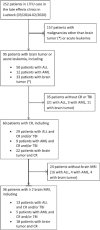Are radiation-induced cavernomas clinically relevant findings? Results from long-term follow-up with brain magnetic resonance imaging of childhood cancer survivors
- PMID: 34384013
- PMCID: PMC8366727
- DOI: 10.2478/raon-2021-0032
Are radiation-induced cavernomas clinically relevant findings? Results from long-term follow-up with brain magnetic resonance imaging of childhood cancer survivors
Abstract
Introduction: Radiation-induced cavernomas (RIC) after cranial radiotherapy have an unknown risk of hemorrhage. Zabramski magnetic resonance imaging (MRI) classification is touted as being able to indicate non-radiation-induced cavernomas hemorrhage risk. The aim of our study was to assess the hemorrhage risk of RIC during long-term follow-up of childhood cancer survivors based on brain MRI examinations.
Patients and methods: We analyzed retrospectively long-term follow-up data of 36 childhood cancer survivors after initial diagnosis with acute leukemia (n = 18) or brain tumor (n = 18), all treated with cranial radiotherapy. Detected RIC in long-term follow-up brain MRI (1.5 or 3 Tesla) were classified following the Zabramski MRI classification and were categorized into "high" (Zabramski type I, II or V) or "low" (type III or IV) risk of hemorrhage.
Results: 18 patients (50%) showed RIC with a significant relation to the original tumor entity (p = 0.023) and the cumulative radiation dose to the brain (p = 0.016): all 9 childhood cancer survivors diagnosed with medulloblastoma developed RIC. We classified RIC in only 3/36 childhood cancer survivors (8%) (1 patient with acute lymphoblastic leukemia [Zabramski type II] and 2 patients with medulloblastoma [type I and type II]) as high risk for hemorrhage, the remaining RIC were classified as Zabramski type IV with low risk for hemorrhage. None of the childhood cancer survivors with RIC showed symptomatic hemorrhages.
Conclusions: RIC are common late effects in childhood cancer survivors treated with cranial radiotherapy affecting half of these patients. However, only a few RIC (occurring in 8% of all reviewed childhood cancer survivors) were classified as high risk for hemorrhage and none of the childhood cancer survivors with RIC developed symptomatic hemorrhages. Thus, we conclude that RIC are low-risk findings in brain MRI and the course is mainly benign.
Keywords: brain magnetic resonance imaging; cavernomas; childhood cancer survivors; cranial radiotherapy; hemorrhage.
© 2021 Lucas Becker, Judith Gebauer, Jan Küchler, Christian Staackmann, Hannes Schacht, Melchior Lauten, Ulf Jensen-Kondering, Peter Schramm, Thorsten Langer, Alexander Neumann, published by Sciendo.
Figures


References
MeSH terms
LinkOut - more resources
Full Text Sources
Medical
